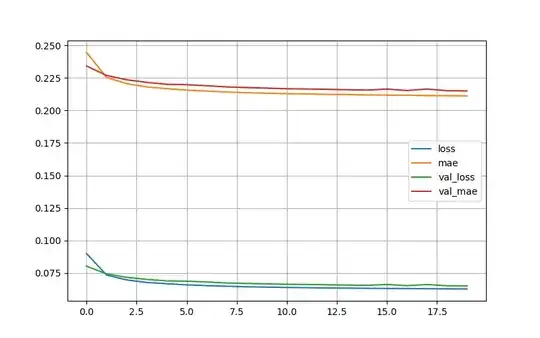I am training a deep neural network using tensorflow in python. I have some inputs and outputs and I want to train my NN for regression problem. I created my NN (I will explain it later), but I have a problem and that is after some epochs, error becomes almost constant and NN seems does not learn anymore. I've tried many solutions such as:
1 - increasing/decreasing number of layers
2 - increasing/decreasing number of neurons
3 - different optimizers
4 - different learning rates
5 - different activation functions
6 - normalizing inputs and outputs
7 - increasing number of epochs
and …. but I couldn't solve the issue. I will be appreciated if anyone can help me with this issue.
here is my python code:
import pandas as pd
import tensorflow as tf
from tensorflow import keras
from sklearn.preprocessing import MinMaxScaler
import matplotlib.pyplot as plt
import numpy as np
input = pd.read_csv("./Data/All_Inputs.txt", delimiter = ",").to_numpy()
output = pd.read_csv("./Data/All_Outputs.txt", delimiter = ",").to_numpy()
x_train = input[0:48000, :]
y_train = output[0:48000, 12:1012]
x_test = input[48000:60000, :]
y_test = output[48000:60000, 12:1012]
x_valid = input[60000:72000, :]
y_valid = output[60000:72000, 12:1012]
scalerInput = MinMaxScaler()
x_train = scalerInput.fit_transform(x_train)
x_test = scalerInput.transform(x_test)
x_valid = scalerInput.transform(x_valid)
scalerOutput = MinMaxScaler()
y_train = scalerOutput.fit_transform(y_train)
y_test = scalerOutput.transform(y_test)
y_valid = scalerOutput.transform(y_valid)
model = keras.models.Sequential()
model.add(keras.layers.Dense(800, activation = "linear", input_shape = x_train.shape[1:]))
model.add(keras.layers.Dense(900, activation = "linear"))
model.add(keras.layers.Dense(900, activation = "linear"))
model.add(keras.layers.Dense(1000, activation = "linear"))
opt = keras.optimizers.SGD(learning_rate = 0.01, momentum = 0.9)
model.compile(loss = "mse", optimizer = opt, metrics=['mae'])
history = model.fit(x_train, y_train, epochs = 20, validation_data=(x_valid, y_valid))
mse_test = model.evaluate(x_test, y_test)
print("\n\nTest set mean squared error is = ", mse_test)
pd.DataFrame(history.history).plot(figsize=(8, 5))
plt.grid(True)
plt.show()
and this is the history of training.
I also tried more epochs like 100 or 300 but the result was not so different and history showed similar nearly flat behavior of curves.
how can I reduce the error of training furthermore?
